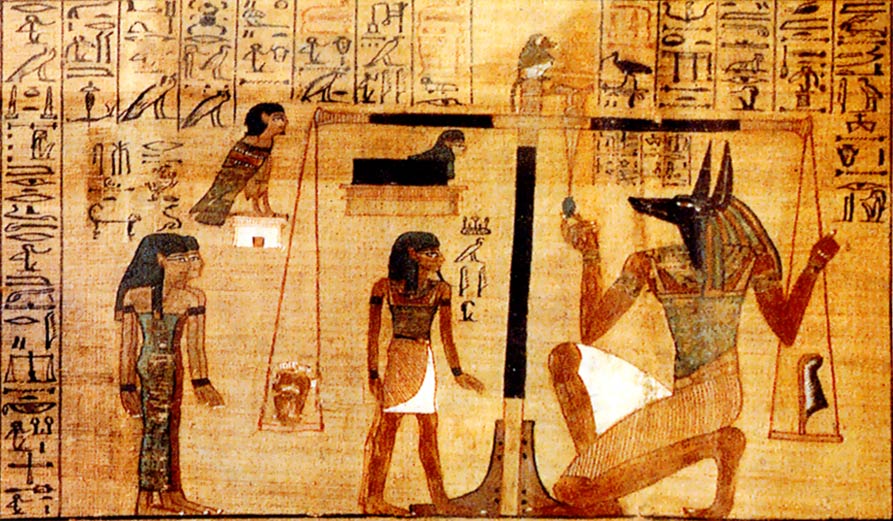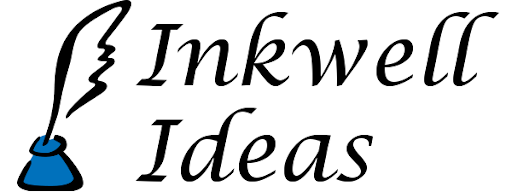Worldbuilding Reference: Cultural Quirks
by Joe Wetzel (joewetzel at gmail dot com)

A portion of the Papyrus of Ani from the Egyptian Book of the Dead.
Physical Characteristics
Unique Physical Features
The people of the culture may have a unique physical feature. Some groups in the world are known for having large noses, red hair, wide feet, or something else that is relatively unique outside of the specific culture.
Physical Distortion
Some cultures ritually distort their physical appearance. One South American Indian tribe would elongate their foreheads by distorting the shape of their skulls at a young age.
Skin Tone
Unfortunately, a person’s skin tone has been used to judge that person and restrict or include him in groups. People tend to feel more comfortable with others who have similar backgrounds and although skin tone may have nothing to do with a person’s background in many cases people will judge someone to have a similar background if they have similar features.
Tattoos
Most of the culture’s people have many tattoos, or perhaps nearly everyone has a tattoo in a particular place.
Body Piercings
While ear piercings are common in western cultures and other piercings are becoming more popular, perhaps in some of your game world’s cultures a different body part is pierced by most people. It may also be that this only applies to one group in the culture (men, women, a race, a religion, etc.) or that the piercings signify a particular event such as marriage or coming-of-age.
Religion
In general many of the other cultural practices could apply to specific religions in the culture, but there are a some that are much more closely related to religion.
The Body After Death
How are the dead treated? They could be burned, placed in cairns, tombs, or perhaps even in larger tombs like pyramids and their servants could be killed with them to serve the deceased in the afterlife.
Marriage
How closely is marriage tied with religion in the culture? Religious leaders may simply have a ceremony or blessing of the marriage, but they might determine who can marry who and even decide if men can have multiple wives or vice versa.
Clothing
Amount of Clothing
A group (race, gender, profession, religion, etc.) is always covered head to toe in clothing (except the eyes) when in public. Many fundamental Islamic women do this.
Clothing Items
A group wears something traditionally associated with a different group in most other cultures. Men in Scotland wear kilts, which are similar to women’s skirts.
Food
Unusual Delicacy
An unusual food is considered a delicacy. The French are famous for escargo, which is simply buttered snails while some parts of the United States (among other places) eat frog legs.
Taboo Foods
Something not considered food by most other cultures is a food in one culture. Perhaps a Rakhasha incident has caused people to want to eat cats.
Vegetarians, etc.
The people do not eat an entire major food group. Perhaps they are all vegetarians, or they avoid starches, vegetables or fish.
Seasonings
A particular spice or sugar may be heavily used. People in the United States use more sugar than in most other places, Indian food is heavy on Curry and many Chinese dishes are spicy-hot.
Gender
Work Roles
Which gender does what types of work? Perhaps men are only allowed to do labor intensive work and women manage and make decisions or vice versa.
Courting
Do the men or the women initiate courting? What’s permissable for one gender or the other while courting? Is there generally a large dowry given by the husband-to-be’s or the wife-to-be’s family?
Symbols
People publicly denote their marriage with a ring, a mark in a visible location, a tattoo, etc. Many western cultures wear a wedding ring while some Indian groups place a dot on a woman’s forehead to signify marriage.
Names
Syllables
Names are many syllables or only one syllable. In some fantasy campaigns, Gnomes have very long names.
Letters Used
Vowels are used excessively or rarely in people’s names in some cultures.
Titles
Titles or castes are included in an individual’s name. This might only apply to nobility or to some other subgroup. Further, the titles may be different depending on the culture. There may be a King vs. a Sultan, etc.
Name Order
In most western cultures a surname comes last. However in many other cultures the surname may be first.
Changing a Name
Names may be changed at certain events. When a marriage occurs, in many cases the wife may take the lastname of the husband.
Language
Speaking
The people mostly talk in metaphors. This may be very hard to pull off, but it was used on a popular science fiction TV show a while back.
Grammar
An odd sentence structure is used. One memorable character from another popular science fiction movie series is well known for his unfamiliar sentence structure. Example: “Named must your fear be before banish it you can.”
Phonetics
Some letter(s) are purposely mispronounced. Castilian Spanish uses a “th” sound for c’s and z’s before i’s and e’s, among other differences.
Tone
English is an unusual language regarding tone. While tone does play into asking a question, words don’t have different meanings depending just on the tone as in other languages.
Writing
Is the written language pictoral or does it have a small set of letters?
Routines
Society
Perhaps the people are nomadic and move from place to place every month or three. Is the culture primarily agricultural? Or maybe many people already live in cities.
Daily Routine
Does everyone take an afternoon nap? Start at the crack of dawn? Perform an hour of service to the government daily? Is the culture is known for eating many meals a day?
Holidays and Festivals
What are the holidays of the country/culture? What types of festivals and traditions are associated with each holiday?
Architecture
Building materials
One distinctive feature of a culture’s architecture is what building materials are used. Often, builders will be somewhat limited by what’s available and what is needed for the climate but a lot of variety may still exist.
Ornamentation
Major buildings may have decorative or functional oranmentation, especially on the top. Castles have their battlements, near eastern temples have minarets, some other buildings have giant domes, gargoyles, etc.
Doors and Windows
Doors and windows are basic essentials for buildings, but variations made to them can make those buildings distinctive. Stained glass windows make some churches stand out for example.
Color
How is color used in architecture? Are only major buildings given color?
Size
How large are the buildings? The size of buildings is limited by the technology (and magic) available.
Magic
Magic can have an incredible effect on what is architecturally possible. How is magic used in construction?
Other
Constellations
The stars in the sky have some meaning. Western cultures found patterns that match the shapes of mythological figures.
Openness
Perhaps because of plagues or raiders or another reason, cities are very closed and difficult to enter.
Combat Trophies
Warriors keep a trophy of their victories. Some American Indians would take a scalp to prove their victory, but another culture could consider a pinky finger or anything as a combat trophy.
Education
How well is the population educated? Are certain races or genders not allowed to be educated?
Music
What is the role of music? Is it used in religious ceremonies? For Entertainment? What instruments are known and used?
Drama
How common are theaters? How often are performances given? Can people earn enough to live as performers?
Slavery
Is slavery accepted? Banned? Mixed reactions? How are people chosen to be enslaved? Debtors, conquered foes, or people/races that look different are all possible targets.
 This work is licensed under a Creative Commons Attribution-Share Alike 3.0 License.
This work is licensed under a Creative Commons Attribution-Share Alike 3.0 License.

Leave a Reply
You must be logged in to post a comment.